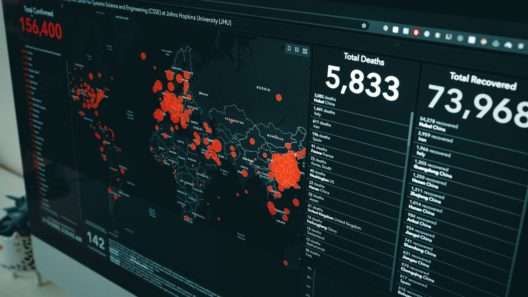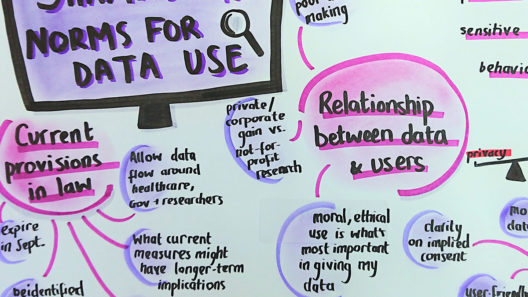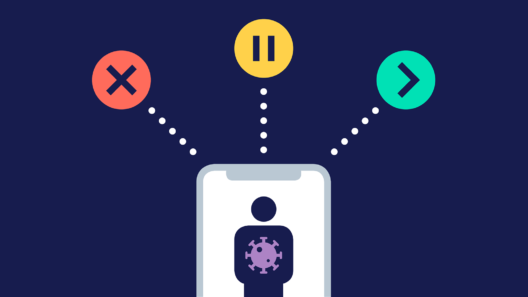Living online: the long-term impact on wellbeing
The Ada Lovelace Institute and Health Foundation’s response to the House of Lords COVID-19 Committee’s call for evidence
8 December 2020
Reading time: 20 minutes

The House of Lords COVID-19 Committee has launched an inquiry into the long-term impact of our rapidly and increasing reliance on digital technology as a result of the COVID-19 pandemic. They are exploring the consequences it may have on our social and economic wellbeing and, in particular, on four key drivers of wellbeing: physical health, mental health, social interaction and quality of working life.
The Ada Lovelace Institute and the Health Foundation jointly submitted this response to the inquiry.
Why are we submitting evidence?
Both the Ada Lovelace Institute and the Health Foundation have programmes of work underway – in collaboration and independently – which examine the impact of data-driven and digital technologies on society and on health and social inequalities. Our joint submission to this Committee is informed by these investigations.
The Ada Lovelace Institute has undertaken a number of projects examining the development of data-driven technologies in response to the pandemic. These have looked at symptom tracking apps, digital contact tracing apps, and immunity certification, through a combination of public deliberation, evidence gathering, expert roundtables and public events. Our work has included the publication of an International monitor of vaccine passports and COVID status apps and the following reports:
- Exit Through the App Store? COVID-19 rapid evidence review
- Crisis of Confidence? Building public trust in digital contact tracing
Digital and data-driven technologies are the focus of a number of projects across the Health Foundation. The Foundation has been examining the roll-out and experiences of virtual consultations, the model of digital-first primary care, and as part of its COVID-19 impact inquiry will be seeking to understand how digital exclusion has interacted with people’s experiences of the pandemic and which groups were most affected by digital exclusion. The wider aim of this inquiry is to understand the impact of people’s health and existing inequalities on their experience of the pandemic, as well as the impact of governmental and societal actions taken in response to COVID-19 on people’s health, social and economic assets.
The Ada Lovelace Institute and the Health Foundation are undertaking a research partnership to examine the interaction between data-driven systems and health and social inequalities in the context of COVID-19. We would be pleased to report back to the Committee on emerging evidence from this or other work.
Summary
- The pandemic has accelerated not only the reliance on digital technologies, but also the use of ‘data-driven’ technologies and systems
- Digital and data-driven technologies have increasingly become a central part of the health infrastructure – a trend accelerated by the pandemic
- There is currently an evidence gap around the long-term impact of these technologies on health and social inequalities
- Similarly, many essential services have shifted online during the pandemic yet the health, social and economic impacts of digital exclusion are not completely understood.
Introduction: wellbeing and the increasing reliance on digital technologies and data-driven systems
The range of digital and data-driven technologies that have emerged in response to the pandemic are broad, both in purpose and design. Data-driven technologies are those that work by collecting, using and analysing data. Whilst at the front end, most people experience these technologies in the guise of an app or a platform, many of these technologies are underpinned by entire systems of data architecture and access. One example of this is Zoe symptom tracking app whereby the app itself serves as an extension of a wider data-driven architecture or system that is used for instance, to support prediction and research. As such, when considering the long-term impact on health and wellbeing of the shift towards using digital technologies, it’s crucial to consider the data-driven systems within which these technologies operate.
Data-driven system captures not just the technologies themselves, but the ways in which they shape the way people work in and across healthcare, the experiences of patients and the public of access to healthcare, and of the COVID-19 health response (particularly, differential experiences). It also captures the nature or purpose of the activity when it is ‘datafied’,1 for instance, contact tracing, a largely manual or a human endeavour, recently supplemented by smartphone-based contact tracing apps.
How will any increasing reliance on digital technology affect the physical health, mental health and social interactions of different groups – older people, children, people with disabilities, ethnic minorities, home-workers – in different ways?
The UK entered the pandemic with a backdrop of widening health and social inequalities and a complex and fragmented healthcare system. Digital technologies and data-driven systems have increasingly become a central part of the health care and public health infrastructure, a trend accelerated by the pandemic. They have offered innovative approaches to address and respond to the impact of the pandemic. They also provide real opportunity to improve health and care services, to improve people’s experience of health and care services, and to improve their health outcomes. Health Foundation funded projects have shown the potential of virtual consultations to improve care and patient experience. Other work has demonstrated the utility of digital-first primary care models in enabling services to respond to the demands of the pandemic and the potential for reducing hospitalisation. The Foundation has also supported numerous projects to improve analytical capability in health and care services and to support the use of healthcare data to improve the quality and safety of services.
When designed and executed well, there is great potential for data-driven approaches to shed light on and address inequalities, as the recognition of the need for high-quality data over the course of the pandemic has illustrated. However, there is also a risk of poorly designed or deployed technologies obscuring or even exacerbating health inequalities. This has been highlighted in recent debates about the impact of immunity or vaccine certification,2 where it has been suggested that these technologies could entrench existing inequalities and create novel forms of discrimination between the immuno-privileged and immuno-deprived. The exacerbation of inequalities risks negatively impacting the physical health, mental health and social interactions of different groups.
With the impact of COVID-19 being felt unequally across society, the risk that digital and data-driven technologies may have an unequal impact on different population groups remains to be examined and addressed.
The partnership between the Ada Lovelace Institute and the Health Foundation will generate an evidence base around the interaction between data-driven systems and health outcomes and build a shared understanding of the actions needed to reduce health inequalities and improve health outcomes.
How will any long-term trend towards increased reliance on digital technology affect our physical health, mental health and social interaction?
Socio-technical systems in a complex environment can sometimes cause unpredictable outcomes for health and social inequalities. In this context, it’s important to be circumspect in forecasting what effect the increased reliance on digital technologies might have on health in the long-term, without modelling the incentives, bureaucracies and cultures in which these technologies are being used.
In addition, technological efforts to implement ‘quick fixes’, could result in perverse or unpredictable outcomes, exacerbating, rather than improving problems. One example is the challenge of ‘missing data’, whereby an absence of particular types of data underrepresents marginalised groups – rendering them invisible and further entrenching their exclusion. For example, missing data on people with learning disabilities meant that their reported death rate from COVID-19 was likely even higher. 3 Efforts instead to ‘overrepresent’ marginalised groups in the data may not address the underlying problem for instance, lack of confidence and trust in the healthcare system.
Limitations with the current evidence base, make it challenging to understand the potential long-term impact of digital and data-driven technologies. For example, in the context of virtual consultations, although many studies have been published, their focus is short-term and patient numbers are small. Moreover, there is only limited data on the health outcomes of patients, making it difficult to understand which patient groups stand to gain the most from virtual consultations.
New research funded by the Health Foundation is aiming to strengthen the evidence base, around virtual consultations. This includes project led by the Nuffield Dept of Primary Care at Oxford University on the scale up and spread of virtual consultations before and during COVID-19 and a project led by Aberdeen University on the role of asynchronous consultations.
Another challenge in evaluating the impact of digital technologies is that the data needed to do so is often fragmented between the public and private sectors. Research into the models of data stewardship funded by the Health Foundation and conducted by the Open Data Institute has argued that everyone involved in technology has a shared responsibility to enable evaluation, whether that means innovators sharing data for evaluation purposes, or healthcare providers being clearer, from the outset, about what data is needed to support effective evaluation. 4
What are the particular social implications for those who cannot, or choose not to, use the internet?
The implications of digital exclusion are wide-ranging. Digital technology offers earnings and employability benefits (finding jobs, better earning), online shopping (which tends to be cheaper), is time saving through enabling access to online services such as banking and government services, and supports remote communication with friends, family and colleagues. 5
The pandemic has exacerbated the impact of digital exclusion. Many essential services such as grocery shopping, banking and healthcare have moved online, some completely, as a result of the COVID-19 pandemic. Additionally, the closure of places which offer a source of ‘free’ Wi-Fi such as public libraries and community centres and lack of support to access the internet due to closure of face-to-face support services is likely to have increased the digital divide as well as the implications of digital exclusion. A range of reports published on the impact of the COVID-19 pandemic highlight the increasing digital divide:
- In a survey of 200 Islington residents to capture their experiences of lockdown and the pandemic more broadly, 83 reported not having accessed any online local support or services. Reasons included no access to a device/internet, lack of skills, impairments, language barriers and homelessness.6
- An evaluation of the GP At Hand service found that the patients who took up the service were younger (94% aged under 45) and two-thirds were living in areas with high proportions of affluent categories. They were also typically healthier than the average.7
- Migrants have also faced significant barriers in accessing services, due to limited funds and language barriers. Crowded accommodation makes it difficult to maintain confidentiality. They are also unable to access guidance on coronavirus, which is changing quickly, requires translation, and mostly available online. 8
- There is concern around issues of digital exclusion for young people in care and in particular access to mental health support.9
- Those without online access and digital skills will have received the least support to search for, and apply to, jobs and yet will be at highest risk of losing their benefits, with proof of job search condition being re-introduced to claim Universal Credit.10
- Digital exclusion during the pandemic has impacted education, particularly for children living in poverty, potentially increasing the attainment gap. Children are unable to use the interactive platforms and don’t have access to the same learning resources.11
What role could digital technology play in increasing opportunities for social interactions?
There have also been some positive impacts in terms of increasing internet use on social interactions. According to a report by Centre for Ageing Better, 75% 50-70 year olds reported making video calls more often and 31% reported emailing more in the lockdown. More importantly, a survey by Lloyds Bank noted a three-fold increase in the number of 70-year olds registering for an online bank account.12 However, the positive impacts may be limited to the subgroup of internet non-users with little previous incentive for internet use, although this is not known.
Addressing gaps in the documentation of impacts on social and economic assets is an important focus for the Health Foundation’s COVID-19 impact inquiry. As part of this inquiry, through our ongoing call for evidence we hope to identify areas for further research and will then aim to highlight the impact of digital exclusion with further analysis. We also plan to conduct an expert roundtable on digital exclusion to identify data sources and relevant literature to help understand the challenges and implications of digital exclusion on the wider determinants of health, as well as recommendations to mitigate these.
What can be done by Government, employers and other organisations to mitigate any negative impact that an increased reliance on digital technology will have on physical health, mental health and social interaction?
It would be valuable to ensure that the work happening across government examining and addressing health inequalities and data-driven systems is better connected and aligned, as tackling health inequalities will require whole-system approach for example with those involved in health, education, and housing. Often work across government is disjointed, especially on complex, wicked problems like health inequalities. Developing a typology of relevant work and public bodies would help to connect this work, as well as setting out proposals for convening and distributing responsibilities, following the model of the House of Lords’ Select Committee on Artificial Intelligence.13
This would be an important step towards government more effectively mitigating the negative impacts of data-driven systems on health equality and in promoting equality by design in government systems. It would also be a valuable resource for those in civil society and the private sector wanting to collaborate with government in addressing these problems.
In the context of the pandemic the Ada Lovelace Institute has previously written about the role for an independent group of advisors on technology in emergencies (GATE) to oversee the development and testing of digital technologies and make recommendations about how to ensure technologies protect privacy by design and by default.14
There are important roles for other key stakeholder such as evaluators, funders, innovators, health and care providers, and patient and practitioner groups to improve the collection, accessibility and use of data to evaluate digital technologies.15
There’s also a need to expand the evidence base on the effect of data-driven systems on health inequalities. The Ada Lovelace Institute has previously written about the importance of public engagement and deliberation in times of crisis. Drawing on first-hand citizen lived experiences of interacting with these systems during the course of the pandemic will provide important insights into the impact on well-being that may not be obvious from quantitative data or third-party observation.
We also believe it would be valuable to reach out to communities who are likely to disproportionately face health inequalities and to be underrepresented in existing policy spaces, e.g. Black, Asian and minority ethnic, LGBTQ+ and disabled communities etc. to actively solicit their opinions alongside wider public engagement.
These could take the form of virtual open ‘town halls’, partnerships with existing community groups in order to solicit evidence from their members through a variety of media, or specifically convened closed discussions organised with polling companies, community groups and patient groups to hear a representative sample of experiences.
More broadly there is a need for meaningful engagement with underrepresented communities throughout the entire process of technology development and deployment. Greater and improved diversity in the digital and technology workforce is one enabler of this engagement and an issue in which the government and employers have a crucial role to play.
- Ada Lovelace Institute (2020) The data will see you now. Datafication and the boundaries of health. 29 October 2020. Available at: https://www.adalovelaceinstitute.org/report/the-data-will-see-you-now/
- University of Exeter (2020). Digital Health Passports for COVID-19. Data Privacy and Human Rights Law. December 2020. Available at: https://socialsciences.exeter.ac.uk/media/universityofexeter/collegeofsocialsciencesandinternationalstudies/lawimages/research/Policy_brief_-_Digital_Health_Passports_COVID-19_-_Beduschi.pdf
- Public Health England (2020). COVID-19: deaths of people with learning disabilities. November 2020. Available at: https://www.gov.uk/government/publications/covid-19-deaths-of-people-with-learning-disabilities
- Open Data Institute (2020). Applying new models of data stewardship to health and care data. July 2020. Available at: http://theodi.org/wp-content/uploads/2020/08/OPEN_ODI_HF_Applying-new-models-of-data-stewardship-to-health-and-care-data-_2020-07-16.pdf
- Cebr (2018) The economic impact of Digital Inclusion in the UK. A report for Good Things Foundation. Centre for Economics and Business Research Ltd. Available at: https://www.goodthingsfoundation.org/sites/default/files/research-publications/the_economic_impact_of_digital_inclusion_in_the_uk_final_submission_stc_0.pdf
- Healthwatch Islington (2020) The impact of COVID-19: Community feedback on life during lockdown. 10 September 2020. Available at: https://www.healthwatchislington.co.uk/report/2020-09-10/impact-covid-19-community-feedback-life-during-lockdown
- Centre for Aging Better (2020) How has COVID-19 changed the landscape of digital inclusion? 11 August 2020. Available at: https://www.ageing-better.org.uk/sites/default/files/2020-08/landscape-covid-19-digital.pdf
- Medact, Migrants Organise & New Economics Foundation (2020) Patients Not Passports—Migrants’ Access to Healthcare During the Coronavirus Crisis. Available at: https://www.medact.org/2020/resources/briefings/patients-not-passports-migrants-access-to-healthcare-during-the-coronavirus-crisis/
- McGhee, K. & Roesch-March, A. (2020) Bridging the digital divide for care experienced young people in Scotland: If not now, when? Centre for Excellence for Children’s Care and Protection. Available at: https://pureportal.strath.ac.uk/en/publications/bridging-the-digital-divide-for-care-experienced-young-people-in-
- Centre for Aging Better (2020)
- Cambridge Centre for Housing and Planning Research (2020) “Pay the wi-fi or feed the children”: Coronavirus has intensified the UK’s digital divide. 6 May 2020. University of Cambridge. Available at: https://www.cam.ac.uk/stories/digitaldivide
- Centre for Ageing Better (2020) Briefing: How has COVID-19 changed the landscape of digital inclusion? Available at: https://www.ageing-better.org.uk/sites/default/files/2020-08/landscape-covid-19-digital.pdf [Accessed: 3 December 2020]
- House of Lords Select Committee on Artificial Intelligence. Report of Session 2017–19. AI in the UK: ready, willing and able? April 2018. Available at: https://publications.parliament.uk/pa/ld201719/ldselect/ldai/100/100.pdf
- Ada Lovelace Institute (2020). Exit through the App Store? Rapid Evidence Review. April 2020. Available at: https://www.adalovelaceinstitute.org/wp-content/uploads/2020/04/Ada-Lovelace-Institute-Rapid-Evidence-Review-Exit-through-the-App-Store-April-2020-2.pdf
- Open Data Institute (2020) Applying new models of data stewardship to health and care data. July 2020. Available at: https://theodi.org/article/applying-new-models-of-data-stewardship-to-health-and-care-data-report/
Related content

Tackling health and social inequalities in data-driven systems
Research to examine the interaction between data-driven systems and health and social inequalities, in the wake of COVID-19.

A rapid online deliberation on COVID-19 technologies: building public confidence and trust
Considering the question: ‘What would help build public confidence in the use of COVID-19 exit strategy technologies?’

It’s complicated: what the public thinks about COVID-19 technologies
Lessons developers and policymakers must learn from the public about COVID-19 technologies.

Pieces in the puzzle: why we need to convene diverse voices
When it comes to the societal impacts of AI and data, we need to tackle complex problems that don’t necessarily have objective solutions.